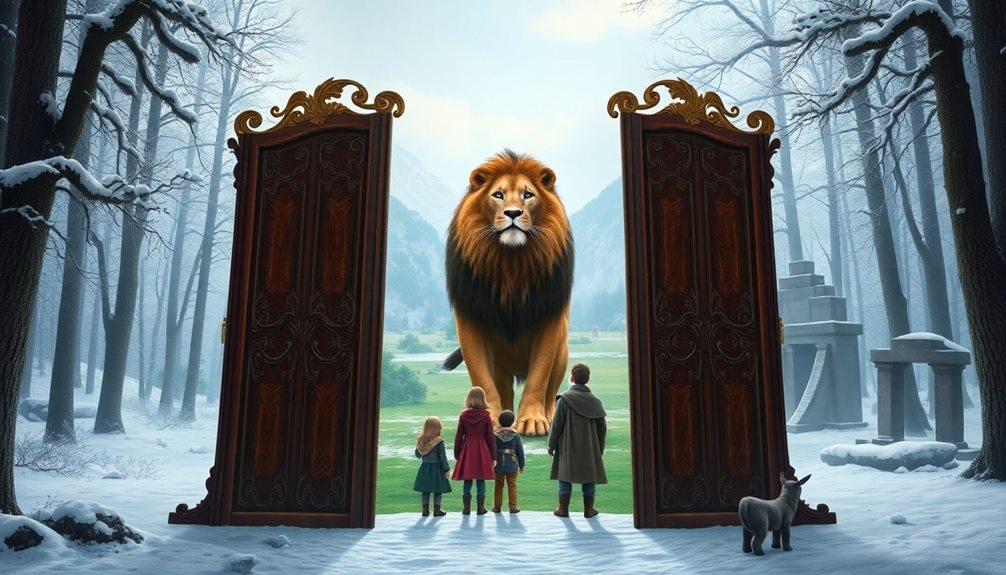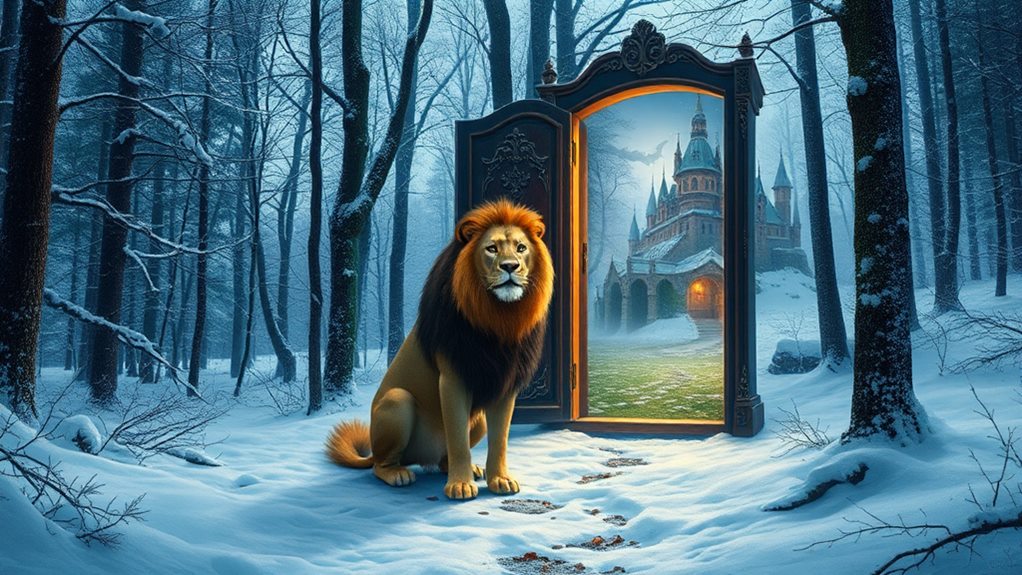C.S. Lewis's 'The Lion, the Witch, and the Wardrobe' invites you into the magical domain of Narnia, where the Pevensie siblings find themselves in a land ruled by the wicked White Witch. As they navigate this enchanted territory, they become part of a prophecy that foretells their role in restoring peace. With the noble lion Aslan guiding them, you'll witness themes of sacrifice, redemption, and the battle between good and evil come to life. The siblings' growth and courage set the stage for an epic adventure, making you enthusiastic to uncover more about their journey and its timeless messages.
Overview of Narnia's Story
Have you ever wondered what adventures await in the magical land of Narnia? "The Lion, the Witch and the Wardrobe" takes you on a journey with the Pevensie siblings—Peter, Susan, Edmund, and Lucy—as they escape the chaos of WWII and stumble upon a hidden world through an ordinary wardrobe.
In Narnia, they discover a land trapped in eternal winter, ruled by the evil White Witch, who symbolizes oppression and despair. The story is steeped in rich lore, with the Deep Magic's influence shaping the very fabric of Narnia's existence and the characters' fates.
The narrative unfolds around a prophecy that foretells the arrival of four human children to end the Witch's reign and restore Aslan, the rightful king, to his throne. As you follow the siblings, you witness their struggles, especially Edmund's betrayal when he aligns himself with the Witch.
However, Aslan, a noble lion, sacrifices himself to save Edmund, showcasing themes of redemption and the power of love.
Ultimately, the siblings unite to confront the Witch, leading to an epic battle that signifies the triumph of good over evil. Their victory not only ends the Witch's tyranny but also allows them to be crowned as the new rulers of Narnia, fulfilling the prophecy and bringing hope back to the magical land.
Key Characters and Arcs
In "The Lion, the Witch, and the Wardrobe," you'll see how the Pevensie siblings grow through their experiences in Narnia, each facing their own challenges and transformations.
Their journey reflects themes of personal growth through challenges, showcasing how adversity can reveal hidden strengths.
Aslan's presence symbolizes not just strength but also the power of sacrifice, particularly in Edmund's journey from betrayal to redemption.
Together, these character arcs highlight the importance of unity, courage, and forgiveness in overcoming darkness.
Sibling Dynamics and Growth
The Pevensie siblings—Peter, Susan, Edmund, and Lucy—each showcase remarkable growth throughout their journey in Narnia, with their dynamics evolving as they confront various challenges. The Pevensie children navigate the complexities of sibling dynamics, highlighting character growth that transforms them from innocent kids into mature individuals.
Edmund's betrayal is pivotal, as it introduces themes of guilt and forgiveness. Initially aligning with the White Witch, he ultimately seeks redemption by embracing the unity of his family.
Meanwhile, Lucy's courage shines through; her discovery of Narnia not only ignites the adventure but also emphasizes the importance of belief in the face of skepticism.
Peter emerges as a natural leader, exhibiting bravery in battle and taking responsibility for his siblings. His protective nature strengthens their bond and inspires them to confront their fears.
Susan, on the other hand, starts with skepticism but learns to accept Narnia's existence. Her journey reflects a balance between caution and support, as she gradually embraces the magical world around her.
Together, the Pevensie siblings' experiences illustrate profound growth, showcasing how their relationships deepen through trials and triumphs in Narnia.
Aslan's Symbolism and Impact
Aslan stands as a powerful symbol of sacrifice and redemption in "The Lion, the Witch, and the Wardrobe." His selfless act of dying for Edmund's betrayal mirrors Christ's crucifixion, establishing a deep narrative connection to themes of forgiveness and hope.
As you explore Narnia, you'll see how Aslan embodies the battle of good versus evil, particularly in his dynamic with the White Witch. This conflict highlights the consequences of tyranny and the essence of courage and loyalty.
Aslan's presence serves as a moral compass for the Pevensie siblings, guiding them through their transformative journey. Each of them, especially Edmund, undergoes significant character development, moving from betrayal to a path of redemption and heroism.
Aslan's sacrifice not only signifies the triumph of good over evil but also reinforces the power of selflessness and hope. His resurrection further emphasizes the themes of transformation and renewal, reminding you that even in darkness, light can emerge.
Ultimately, Aslan's impact on the Pevensie siblings shapes their destinies as the rightful rulers of Narnia, showcasing the profound effects of his character throughout the narrative.
Edmund's Redemption Journey
Edmund's journey through betrayal and redemption captivates readers as he transforms from a morally weak character into a symbol of courage and integrity. Initially, he betrays his siblings under the White Witch's seductive promises of power and Turkish delight. This moral failure leads to his imprisonment, forcing him to confront the consequences of his actions.
The pivotal moment comes when Aslan sacrifices himself on the Stone Table in Edmund's place, illustrating profound themes of redemption and forgiveness. This selfless act sets the stage for Edmund's transformation.
After Aslan's resurrection, you see him emerge as a loyal ally, joining forces with his siblings to confront the White Witch. His newfound courage shines through as he battles against his past mistakes and fights for Narnia's freedom.
Major Themes Explored

Conflict serves as a driving force in "The Lion, the Witch and the Wardrobe," highlighting major themes that resonate throughout the narrative. At its core is the battle between good and evil, embodied by Aslan and the White Witch. This struggle invites you to explore deeper themes like sacrifice and redemption, reminiscent of stories that showcase the resilience of the human spirit, such as Louis Zamperini's survival during WWII in his remarkable journey.
Aslan's selfless act of giving his life for Edmund showcases the power of forgiveness, emphasizing how personal growth often arises from challenging circumstances.
The story also weaves in elements of prophecy, which guide the Pevensie siblings toward their destinies and highlight their crucial roles in restoring Narnia's peace.
Key themes include:
- Friendship and Loyalty: The bonds between the siblings and their allies prove essential in overcoming adversity.
- Courage: The Pevensie children evolve from ordinary kids into brave leaders through their experiences.
- Good and Evil: The clear delineation between Aslan's goodness and the Witch's malevolence underscores the importance of moral choices.
These themes enrich the narrative, offering you profound insights into human nature and the values that shape our lives.
Aslan's Role and Sacrifice
Aslan stands as a powerful symbol of sacrifice and redemption in Narnia. His presence evokes a haunting atmosphere similar to that of Manderley, where hidden truths and dark legacies shape the narrative.
When he gives his life for Edmund, he illustrates the depth of selfless love and atonement, making his resurrection even more poignant. This act not only brings hope but also emphasizes the ongoing battle between good and evil, inviting you to reflect on its significance, much like the themes of jealousy and psychological depth found in *Rebecca* the psychological turmoil of characters.
Aslan's Symbolic Significance
In the enchanting world of Narnia, the great lion stands as a powerful symbol of sacrifice and redemption. Aslan embodies the themes of forgiveness and atonement, especially through his sacrificial death at the Stone Table in place of Edmund. This act of selflessness illustrates the profound depth of love and the ability to overcome one's mistakes.
Aslan's resurrection is a pivotal moment that underscores the triumph of good over evil. This event not only brings hope but also highlights the transformative power of self-sacrifice in the face of darkness. The deeper magic of Narnia, which allows for Aslan's return, signifies a moral order that transcends the immediate actions of the characters.
Consider these key aspects of Aslan's significance:
- His sacrificial act represents the essence of redemption.
- The resurrection showcases the eternal victory of good over evil.
- Allegorical interpretations connect Aslan to Christ-like imagery, reflecting themes of faith.
Through these lenses, Aslan serves as a powerful reminder of the enduring hope that emerges from sacrifice, encouraging readers to reflect on the deeper meanings behind the narrative.
The Sacrifice Explained
The act of sacrifice in "The Lion, the Witch, and the Wardrobe" unfolds dramatically through Aslan's willingness to lay down his life for Edmund. This selfless act comes after Edmund's betrayal, aligning him with the White Witch, who demands Aslan's life as payment. Aslan, embodying a Christ-like figure, accepts this fate, showcasing the profound themes of sacrifice and redemption. His death on the Stone Table marks a pivotal moment, symbolizing the ultimate love and selflessness, as he bears the punishment intended for Edmund.
Aslan's sacrifice serves as a powerful allegory for the battle between good and evil. It reveals that even in the face of betrayal, love can triumph. The narrative emphasizes that true sacrifice doesn't end in defeat; it paves the way for resurrection.
The deeper magic in Narnia guarantees Aslan's return, illustrating that sacrifice can lead to victory over darkness. After his resurrection, Aslan rallies the forces of good, proving his role as the true ruler and savior of Narnia. This sequence of events reinforces the moral that redemption is attainable, even after the gravest of betrayals, underscoring the triumph of good over evil.
Resurrection and Hope
There's a palpable sense of hope that emerges following Aslan's resurrection in "The Lion, the Witch, and the Wardrobe." His return from the dead serves as a powerful reminder that love and sacrifice can conquer even the darkest moments.
Aslan's sacrifice at the Stone Table not only redeems Edmund but also sets the stage for his own resurrection, showcasing the deeper magic of Narnia, which promises that death can be undone for the innocent.
This moment transforms the narrative, igniting a resurgence of hope among the children and Narnia's inhabitants. Aslan's role as a symbol of hope becomes even more pronounced as he rallies everyone against the White Witch, leading them to triumph.
- Aslan's sacrifice embodies the ultimate act of redemption.
- His resurrection inspires unity and courage against evil.
- The themes of sacrifice and resurrection reflect Christian allegories.
Ultimately, Aslan's presence in the final battle reinforces the message of good triumphing over evil, providing a beacon of hope for all who seek redemption in the land of Narnia.
Reception and Cultural Impact

"Reception and Cultural Impact" of "The Lion, the Witch and the Wardrobe" highlights its remarkable journey through literature and media. Since its publication, this classic fantasy has sold over 100 million copies globally and has been translated into 47 languages, showcasing its widespread appeal.
The book's enduring popularity is evident, as it ranked ninth on BBC's The Big Read poll in 2003 and was included in Time magazine's 100 Best Young-Adult Books of All Time. Its themes of courage and adventure resonate deeply, allowing readers to experience a sense of escapism and enhance their mood through reading.
You can see how this beloved story has influenced the fantasy genre, inspiring countless authors and becoming a cornerstone of modern children's literature. The Narnia series continues to resonate with readers of all ages, illustrating the universal themes of courage, sacrifice, and redemption.
Adaptations have further cemented its cultural impact, with three successful films grossing over $1.5 billion worldwide. These adaptations allow new audiences to experience the magic of Narnia, ensuring that "The Lion, the Witch and the Wardrobe" remains a touchstone for generations.
Its combination of rich storytelling and compelling characters guarantees that this classic will endure in the hearts and minds of readers everywhere.
Adaptations Across Media
C.S. Lewis's "The Lion, the Witch, and the Wardrobe" has been adapted into various media, showcasing its enduring appeal. The enchanting atmospheres found in the best bookstores can often mirror the magical world of Narnia, creating a unique experience for readers.
You can see this classic tale transformed in several forms, each bringing the magical world of Narnia to life in unique ways:
- Live-action film: The 2005 adaptation grossed over $745 million globally, introducing a new generation to the story.
- Stage productions: The Royal Shakespeare Company and various touring companies have delivered mesmerizing live performances, immersing audiences in the enchanting narrative.
- Animated adaptations: The 1979 film and a 1988 BBC miniseries highlight the timeless nature of Lewis's work, appealing to fans of all ages.
In addition to visual adaptations, "The Lion, the Witch, and the Wardrobe" has seen audio adaptations such as radio shows and audiobooks, broadening its reach.
Video games and interactive experiences further engage fans, making the story accessible in innovative ways. These adaptations not only celebrate the original tale but also invite you to explore the rich, magical world of Narnia through diverse mediums.
Legacy of the Chronicles

How has "The Lion, the Witch, and the Wardrobe" shaped the landscape of children's literature? This classic children's fantasy novel, part of the Chronicles of Narnia series, has sold over 100 million copies worldwide, demonstrating its profound impact.
Written by C.S. Lewis, it introduces you to Peter and Susan, along with their siblings, as they initiate a magical journey that includes encounters with talking animals and the formidable Queen of Narnia. The themes of courage and personal growth echo the masterful portrayal of resilience found in classic literature, connecting it to the broader literary canon.
The series, beginning with this groundbreaking book, has influenced countless authors and narratives in the children's fantasy genre. Its rich storytelling and moral lessons resonate with readers of all ages, securing its place in educational reading lists. The character of Professor Digory adds layers of depth, linking themes of courage and friendship throughout the series.
Adapted into films, stage productions, and animated series, the Chronicles of Narnia continue to captivate audiences globally, highlighting their cultural significance.
Conclusion
In the enchanting domain of Narnia, you've journeyed through triumphs and trials, witnessing the battle between good and evil. As you close the book, the echoes of Aslan's roar linger, a reminder of hope and redemption. Each character's growth mirrors your own, urging you to embrace courage and compassion. The magic of "The Lion, the Witch, and the Wardrobe" doesn't just fade; it weaves itself into the fabric of your imagination, inviting you to explore new realms of possibility.



